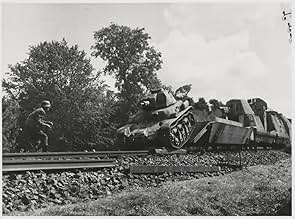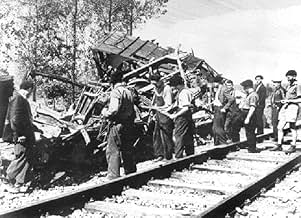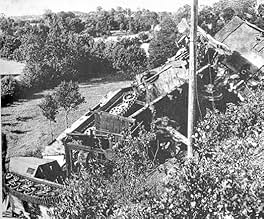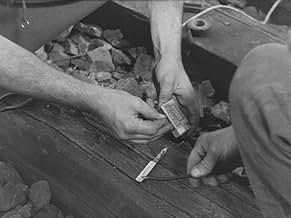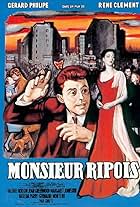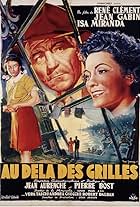IMDb RATING
7.0/10
1.4K
YOUR RATING
Recounts the courageous efforts by French railroad workers who were part of an organized resistance during German World War II occupation.Recounts the courageous efforts by French railroad workers who were part of an organized resistance during German World War II occupation.Recounts the courageous efforts by French railroad workers who were part of an organized resistance during German World War II occupation.
- Awards
- 3 wins & 1 nomination total
Marcel Barnault
- Cheminot
- (as Barnault)
Jean Clarieux
- Lampin
- (as Clarieux)
Jean Daurand
- Cheminot
- (as Daurand)
Lucien Desagneaux
- Athos
- (as Desagneaux)
François Joux
- Cheminot
- (as Joux)
Pierre Latour
- Cheminot
- (as Latour)
Robert Le Ray
- Chef de gare
- (as Leray)
Pierre Lozach
- Cheminot
- (as Lozach)
Pierre Mindaist
- Cheminot
- (as Mindaist)
Léon Pauléon
- Chef de gare St-André
- (as Pauleon)
Fernand Rauzéna
- Cheminot
- (as Rauzena)
Michel Salina
- Allemand
- (as Salina)
Charles Boyer
- Narrator
- (voice)
- (uncredited)
- Director
- Writers
- All cast & crew
- Production, box office & more at IMDbPro
Featured reviews
A hidden gem l just discovered !! Tells it like it was !! Dirty , hard , people died . Very good de-railment scene towards the end !! A real derailment excellently shot !
For cinema enthusiasts, it is important to learn that the value of trains in the field of cinema has always been justly understood by filmmakers as truthful portrayals of trains have been extremely useful in making films which have become extremely popular with critics as well as with viewers. It would be appropriate to state that most of the films about war have an air of authenticity due to the realistic depiction of trains in them. It would not be an exaggeration to state that war films are popular due to the portrayal of trains in them. La Bataille Du Rail/The Battle of the Rails is the best example of a war film with trains and their impact on war as its major plot. The success of this film is due to the efforts of ordinary railway workers in war time France who were quick to realize that the damage to railway system in occupied France would be a key weapon in their fight against Nazi Germany. Those who favor technology in cinema would be shocked to learn how professionally the massive annihilation of trains was carried out in "The Battle of the Rails" despite the evident lack of technology. In 1946, this film by René Clément won a jury prize at Cannes Film Festival. In recent times, La Bataille Du Rail/The Battle of the Rails has been hailed as one of the classics of world cinema as it was shown in "Cannes Classics" section during 63rd Cannes International Film Festival held in 2010. Hardcore cinema enthusiasts would be thrilled to learn that it has been fully restored by INA in France where it can also be watched on DVD as well as Blu Ray formats.
This movie is not great. It's good, and it's only ok if you've already seen The Train 1964. This 1946 movie is artistic, stark, neo realist, blah blah, like many post war European made movies from the era. But it lacks character study and has only tactical measures and rebelliousness against not-so-evil Nazis as the reason for being, unlike The Train.
Army of Shadows 1969 is another example of a refined, not-so-purist remake of previous movies. It was just done better and had a longer lasting impact, like The Train.
But telling fans of La Bataille Du Rail that it's overrated just gets a lot of dislikes. Examine both movies yourself, but make sure you watch the 1946 movie FIRST so you won't be disappointed.
Army of Shadows 1969 is another example of a refined, not-so-purist remake of previous movies. It was just done better and had a longer lasting impact, like The Train.
But telling fans of La Bataille Du Rail that it's overrated just gets a lot of dislikes. Examine both movies yourself, but make sure you watch the 1946 movie FIRST so you won't be disappointed.
Based on real life events that occurred between the Normandy Landings and the liberation, La Bataille du Rail was commissioned by the Associations of the Resistance soon after the end of the Second World War. That a war film would be put into production so soon after the end of the war and that it would prove so successful with a public that lived through it suggests a desire to show the extent of the resistance's achievements and the pride of the French.
However, Clément carefully avoids making the film too didactic or sentimental. We can see how the ruthlessness of the occupying forces in rooting out the saboteurs and their anti-Semitism is not overplayed as their portrayal seems appropriate to a modern audience not directly scarred by the events shown. Another way in which he achieves this is through the way the camera stays relatively detached from the action, showing the events almost like a documentary rather than forcing us to identify with any of the characters. It has been said that the cast was made up of unprofessional actors and in some cases real railwaymen. This adds to the realism and creates an effect where no one film star stands out as an obvious "hero", enforcing a message of "ordinary men doing what they had to".
However, Clément carefully avoids making the film too didactic or sentimental. We can see how the ruthlessness of the occupying forces in rooting out the saboteurs and their anti-Semitism is not overplayed as their portrayal seems appropriate to a modern audience not directly scarred by the events shown. Another way in which he achieves this is through the way the camera stays relatively detached from the action, showing the events almost like a documentary rather than forcing us to identify with any of the characters. It has been said that the cast was made up of unprofessional actors and in some cases real railwaymen. This adds to the realism and creates an effect where no one film star stands out as an obvious "hero", enforcing a message of "ordinary men doing what they had to".
THE BATTLE OF THE RAILS is a rare little title that I managed to catch on Talking Pictures TV here in the UK in the first showing since 1960. It's a black and white drama about the efforts of the French Resistance to sabotage Nazi-controlled trains during WW2. The film is made with a documentary realism in which the action is narrated throughout. The photography is excellent and the pacing is fast. The film abandons typical conceits of characterisation and dialogue in favour of a focus on physical action, such as the sabotaging of tracks and trains and the subsequent derailments that follow. It's surprisingly tense, even thrilling at times.
Storyline
Did you know
- TriviaIn part financed by what had been the Resistance as a way of showing international audiences what the French population had been facing under Nazi oppression. The Resistance was also keen to let the world know that they had been actively involved in disrupting the German war machine in France as the international perception at the time was that the French had capitulated and collaborated a little too easily with their Nazi captors.
- GoofsRailway worker tapping Morse code just repeats letter "V" most of the time with only a few exceptions.
- Crazy credits(in cast) et Les cheminots de France
- ConnectionsFeatured in Cannes... les 400 coups (1997)
- How long is The Battle of the Rails?Powered by Alexa
Details
- Release date
- Country of origin
- Official site
- Languages
- Also known as
- Bitka za prugu
- Filming locations
- Gare SNCF, Saint-Brieuc, Côtes-d'Armor, France(first scenes, train station)
- Production companies
- See more company credits at IMDbPro
- Runtime1 hour 25 minutes
- Color
- Sound mix
- Aspect ratio
- 1.37 : 1
Contribute to this page
Suggest an edit or add missing content

Top Gap
By what name was The Battle of the Rails (1946) officially released in Canada in English?
Answer
